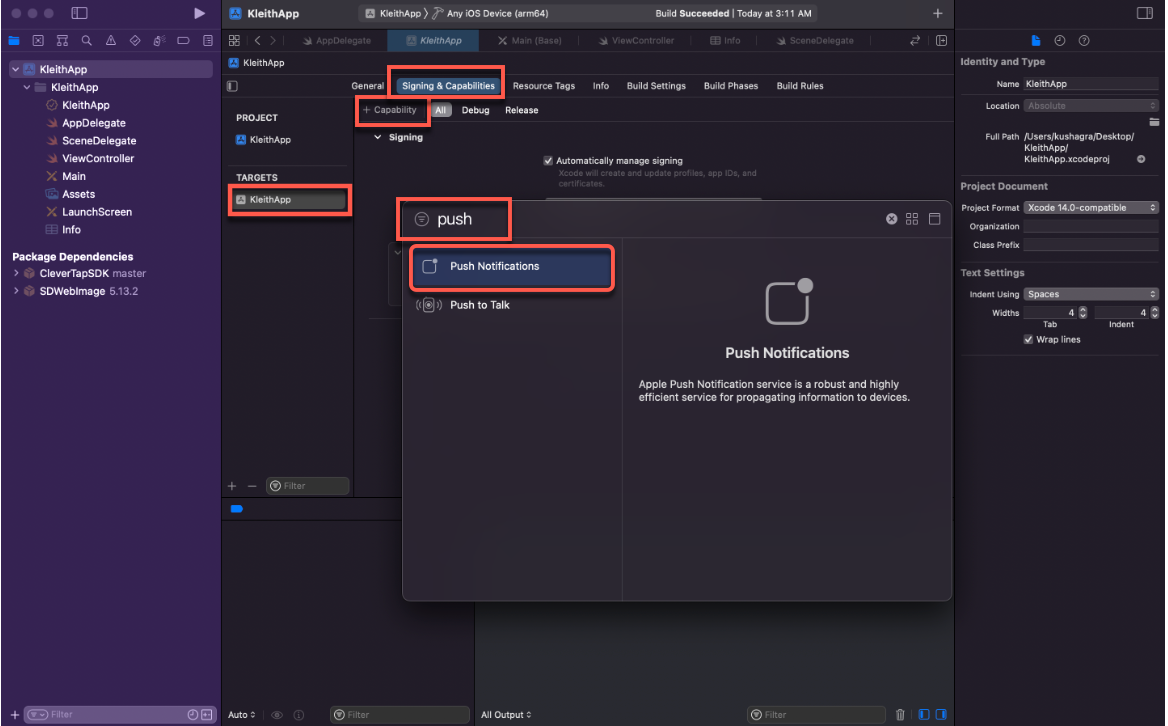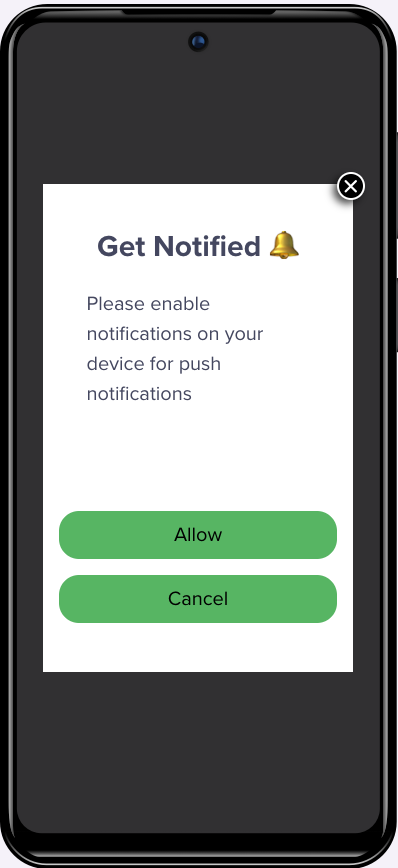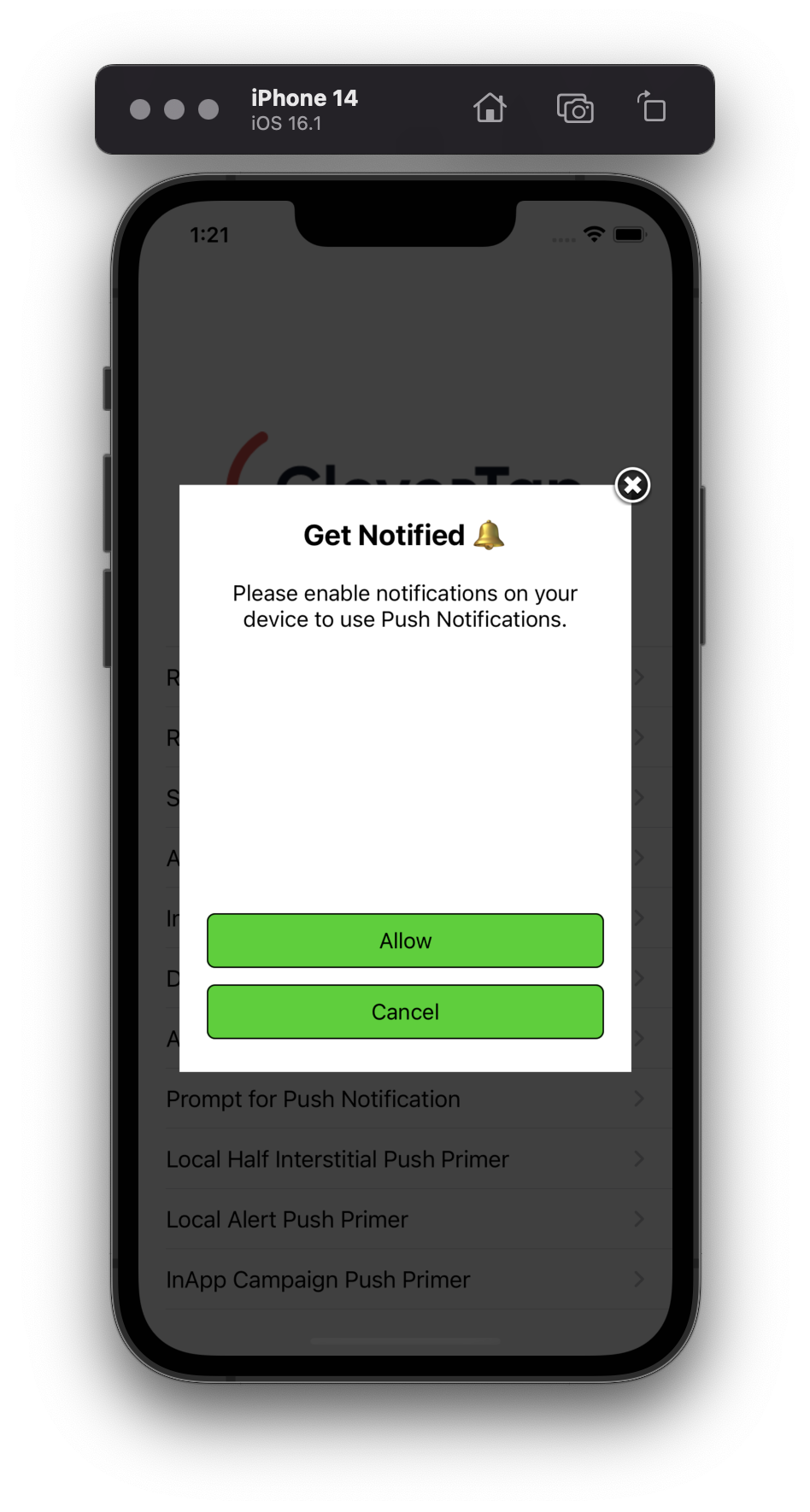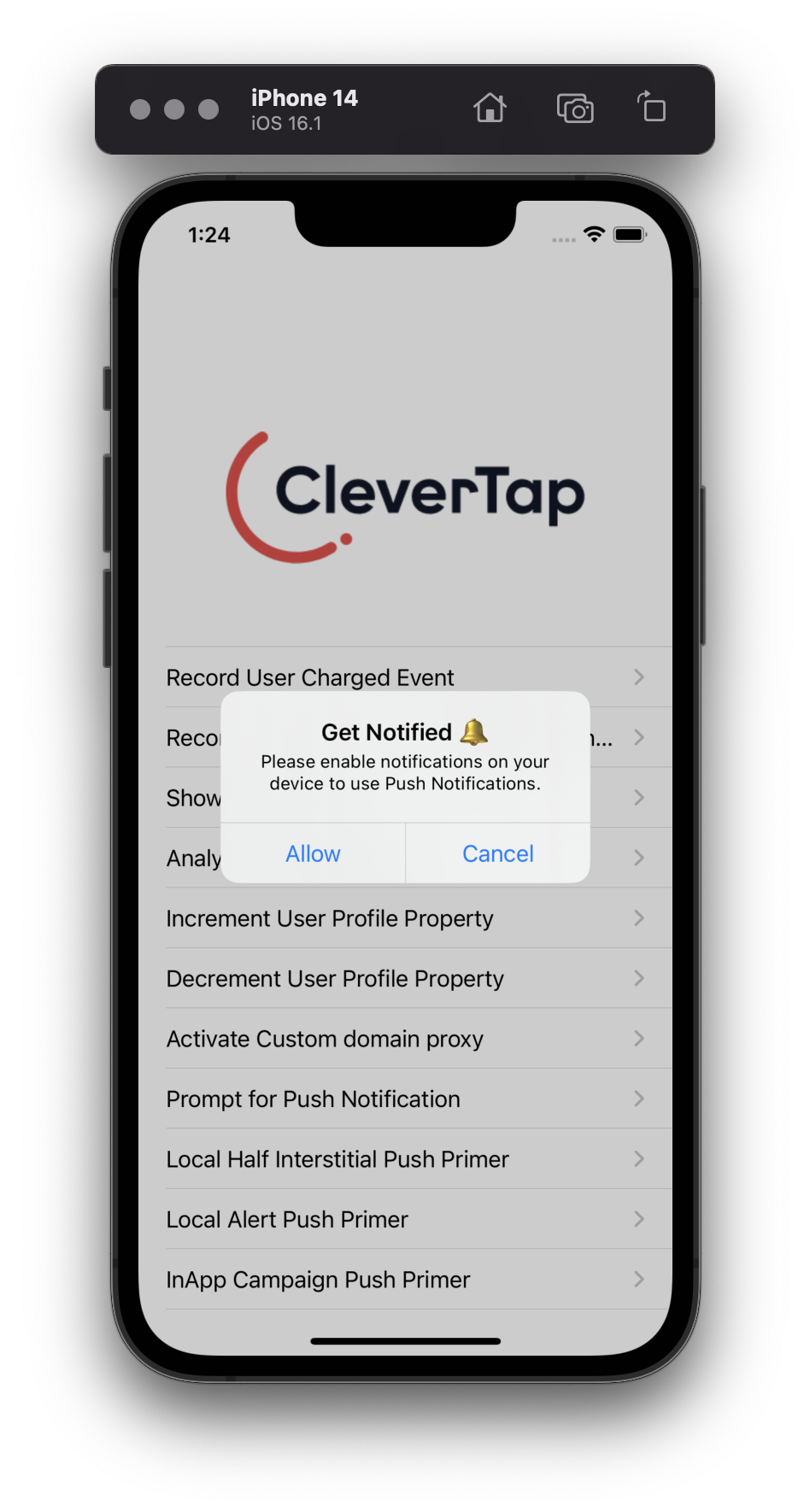React Native Push
Learn how to handle push notifications in React Native.
Push Notifications
CleverTap React Native SDK allows you to send push notifications to your React Native applications from the CleverTap dashboard. Using push notifications, you can push information to your users even when they are inactive.
Android
To use CleverTap's default Push Notifications service, add the following entries to your AndroidManifest.xml:
<application>
....
....
<service android:name="com.clevertap.android.sdk.pushnotification.fcm.FcmMessageListenerService" android:exported="true">
<intent-filter>
<action android:name="com.google.firebase.MESSAGING_EVENT" />
</intent-filter>
</service>
</application>
📘 Notification Trampolines in Android 12 and AboveAndroid has changed the handling of push notifications for version 12 and above to improve performance. An app can no longer start an activity within a service or broadcast receiver. For more information, refer to Android 12 Push Changes.
Create Notification Channel
NoteYou must register at least one notification channel for the Default Push notification Service to work.
Add the following to your Javascript file to create a notification channel:
CleverTap.createNotificationChannel("CtRNS", "Clever Tap React Native Testing", "CT React Native Testing", 5, true) // The notification channel importance can have any value from 1 to 5. A higher value means a more interruptive notification.The notification channel importance can have any value from 1 to 5. A higher value means a more interruptive notification. For more information, refer to Notification Channel Importance Levels.
Delete Notification Channel
Add the following to your Javascript file to delete a notification channel:
CleverTap.deleteNotificationChannel("RNTesting");Create a group notification channel
Add the following to your Javascript file to create a group notification channel:
CleverTap.createNotificationChannelGroup("groupID", "groupName");Handle Push Notification Callback
The CleverTap SDK sends the callback when a Push Notification is clicked along with the entire payload. For this, you must register the CleverTapPushNotificationClicked callback using the following code:
CleverTap.addListener(CleverTap.CleverTapPushNotificationClicked, (e)=>{/*consume the event*/})Additional handling to get the notification click callback in the following scenarios:
- Notification Trampoline Handling in Android 12 and Above
- Notification Trampoline Handling when the App is Terminated or Killed
Handle Notification Trampolines in Android 12 and Above to get the Notification Click Callback
Due to notification trampoline restrictions, Android 12 and above do not directly support the CleverTap.CleverTapPushNotificationClicked callback. Hence, apps need to add manual handling for Android 12 and above to inform the CleverTap SDK about the notification click and get the CleverTap.CleverTapPushNotificationClicked callback.
Add the following code in the onNewIntent() method of the Launcher ReactActivity:
class MainActivity : ReactActivity() {
override fun onNewIntent(intent: Intent?) {
super.onNewIntent(intent)
// On Android 12 and onwards, raise notification clicked event and get the click callback
if (Build.VERSION.SDK_INT >= Build.VERSION_CODES.S) {
cleverTapDefaultInstance?.pushNotificationClickedEvent(intent!!.extras)
}
}
}For detailed information, refer to Android 12 Push Changes.
Handle Notification Click Callback when the App is Terminated or Killed
None of the previously mentioned handlings support the CleverTap.CleverTapPushNotificationClicked callback in the killed state. To achieve this, your Android platform-specific Application class should extend the CleverTapApplication class instead of the Application class.
import com.clevertap.react.CleverTapApplication;
public class MainApplication extends CleverTapApplication implements ReactApplication {
@Override
public void onCreate() {
CleverTapAPI.setDebugLevel(CleverTapAPI.LogLevel.VERBOSE);
// ActivityLifecycleCallback.register(this); Required only for v2.2.1 or below
super.onCreate();
//rest code
}
}Enable RenderMax with Android
Starting from CleverTap React Native SDK version 1.2.0, the RenderMax Push SDK functionality is now supported directly within the CleverTap Android SDK. We strongly recommend updating to CleverTap React Native SDK to version 1.2.0 and CleverTap Android SDK to version 5.2.0 to take advantage of this integration and to ensure stability.
Please remove the integrated RenderMax SDK before you upgrade to CleverTap React Native SDK v1.2.0.
Custom Rendering with RenderMax Push SDKIf the app is custom rendering the push notification and not passing the payload to CleverTap SDK, add the following code before you render the notification:
CleverTapAPI.processPushNotification(getApplicationContext(),extras);
Set Up a Custom Push Notification Icon
By default, CleverTap SDK uses the app's icon for both the notification icon and the notification bar icon. However, You can provide a custom app icon by adding the icon in your app's android resources and registering it with CleverTap in your AndroidManifest.xml
For more details, refer to Android Push document.
Delete a Group Notification Channel
Add the following to your Javascript file to delete a group notification channel:
CleverTap.deleteNotificationChannelGroup("groupId");Handle Custom Push Notification Service
If you have your custom implementation for managing Android push notifications, you can inform CleverTap about the user’s FCM registration ID. Refer to Advanced Features Section for more information
Deeplink or External URL (Android)
To use external URLs, whitelist the IPs or prefix the URL with http or https. For more information, refer to Deeplinking.
iOS
Perform the following steps to send push notifications on the iOS platform from your React Native application:
-
Refer to iOS Push Notifications setup and follow steps 1 through 4 listed in the document.
-
In your Xcode project settings, perform the following steps to enable the push notification capability:
a. Select Targets and then select the Signing & Capabilities tab.
b. Click + Capability and enter push in the filter field and select Push Notifications.

Enable Push Notification Capability
- Call the following from your Javascript file:
CleverTap.registerForPush();- Create a Push Notification campaign on CleverTap or follow the steps listed under CleverTap iOS Push Notifications.
iOS Foreground Notifications
To receive push notifications when your app is in the foreground, check your AppDelegate class conforms to theUNUserNotificationCenterDelegate and then add userNotificationCenter:willPresentNotification:withCompletionHandler: delegate method in your AppDelegate class.
- (void)userNotificationCenter:(UNUserNotificationCenter *)center willPresentNotification:(UNNotification *)notification withCompletionHandler:(void (^)(UNNotificationPresentationOptions options))completionHandler{
completionHandler(UNAuthorizationOptionSound | UNAuthorizationOptionAlert | UNAuthorizationOptionBadge);
}func userNotificationCenter(_ center: UNUserNotificationCenter,
willPresent notification: UNNotification,
withCompletionHandler completionHandler: @escaping (UNNotificationPresentationOptions) -> Void) {
completionHandler([.badge, .sound, .alert])
}Handle React Native Push Notification Callback on iOS
The CleverTap SDK sends a callback when a Push Notification is clicked along with the entire payload. For this, you must register the CleverTapPushNotificationClicked callback in your Javascript file, as shown below:
CleverTap.addListener(CleverTap.CleverTapPushNotificationClicked, (e)=>{/*consume the event*/})Deeplink or External URL (iOS)
A deeplink helps you open a particular activity in your app after a click on the notification. If left empty, the notification on click opens the launcher activity of the app. Deep links allow you to land users on a particular part of your app. Your app's OpenURL method is called with the deep link specified here. To use external URLs, you must whitelist the IPs or add http/https before the URL so that the SDK can appropriately handle them. For more information, refer to Deeplinking.
With CleverTap React Native SDK, you can implement custom handling for URLs of in-app notification CTAs, push notifications, and app Inbox messages.
Check that your class conforms to the CleverTapURLDelegate protocol by first calling setURLDelegate. Use the following protocol method shouldHandleCleverTap(_ : forChannel:) to handle URLs received from channels such as in-app notification CTAs, push notifications, and app Inbox messages:
#import <CleverTapSDK/CleverTapURLDelegate.h>
// Set the URL Delegate
[[CleverTap sharedInstance]setUrlDelegate:self];
// CleverTapURLDelegate method
- (BOOL)shouldHandleCleverTapURL:(NSURL *)url forChannel:(CleverTapChannel)channel {
NSLog(@"Handling URL: \(%@) for channel: \(%d)", url, channel);
return YES;
}// Set the URL Delegate
CleverTap.sharedInstance()?.setUrlDelegate(self)
// CleverTapURLDelegate method
public func shouldHandleCleverTap(_ url: URL?, for channel: CleverTapChannel) -> Bool {
print("Handling URL: \(url!) for channel: \(channel)")
return true
}Enable Support for Deeplink Tracking Manually in the Application
Refer to iOS Deeplink Tracking for reference.
Push Impression in iOS
You can now raise and record push notifications delivered to your user's iOS devices. To raise Push Impressions for iOS, you must enable the Notification Service Extension on your native iOS side. For more information, refer to our iOS Push Impressions documentation.
Push Notifications Permission
Starting from Android 13 and iOS 10.0, applications must request notification permission from the user before sending Push Notifications. All newly-installed applications must seek user permission before they can send notifications.
Push Primer
A Push Primer explains the need for push notifications to your users and helps to improve your engagement rates. It is an InApp notification that you can show to your users before requesting notification permission.
Push Primer helps with the following:
- Allows you to educate your users on why you are asking for this permission before invoking a system dialog to seek user permission.
- Acts as a precursor to the hard system dialog and thus allows you to seek permission multiple times if previously denied without making your users search the device settings.
CleverTap React Native supports push primer for push notifications starting with the v0.9.5 release.
iOS and Android Versions for Push Primer
- The minimum supported version for the iOS platform is 10.0.
- The minimum supported version for the Android platform is Android 13.
The following are the two ways to handle the new push notification changes:
- Push Primer Using Half-Interstitial InApp Notification Template
- Push Primer Using In-App Alert Template
Push Primer Using Half-Interstitial InApp Template
Using this template, you can send a customized push primer notification with an image, text, and button. You can also modify the notification's text, button, and background color.
Refer to the following images for Push Primer using Half-Interstitial InApp Template:
- In Android

Push Primer Using Half-Interstitial InApp Template in Android
- In iOS

Push Primer Using Half-Interstitial InApp Template in iOS
Add the following code to your Javascript file to create Push Primer using the Half-Interstitial InApp template:
let localInApp = {
inAppType: 'half-interstitial',
titleText: 'Get Notified',
messageText: 'Please enable notifications on your device to use Push Notifications.',
followDeviceOrientation: true,
positiveBtnText: 'Allow',
negativeBtnText: 'Cancel',
// Optional parameters:
backgroundColor: '#FFFFFF',
btnBorderColor: '#0000FF',
titleTextColor: '#0000FF',
messageTextColor: '#000000',
btnTextColor: '#FFFFFF',
btnBackgroundColor: '#0000FF',
btnBorderRadius: '2',
// Setting this to true will open an in-app redirect to the mobile OS settings page
fallbackToSettings: true,
imageUrl: 'https://icons.iconarchive.com/icons/treetog/junior/64/camera-icon.png',
altText: 'Alternate Image'
};
CleverTap.promptPushPrimer(localInApp);Push Primer using Alert InApp Template
Using this template, you can create a basic push primer notification with a title, message, and two buttons.
Refer to the following images for Push Primer using the Alert InApp template:
- In Android

Push Primer using Alert InApp Template in Android
- In iOS

Push Primer using Alert InApp Template in iOS
Add the following code to your Javascript file to create a Push Primer using the Alert InApp template:
let localInApp = {
inAppType: 'alert',
titleText: 'Get Notified',
messageText: 'Enable Notification permission',
followDeviceOrientation: true,
positiveBtnText: 'Allow',
negativeBtnText: 'Cancel',
fallbackToSettings: true, //Setting this parameter to true will open an in-App to redirect you to Mobile's OS settings page.
};
CleverTap.promptPushPrimer(localInApp);Method Description
The following table describes all the keys used to create In-App templates:
Key Name | Parameters | Description | Required |
|---|---|---|---|
| "half-interstitial" or "alert" |
| Required |
| String | Sets the title of the local in-app notification. | Required |
| String | Sets the subtitle of the local in-app notification. | Required |
| true or false |
| Required |
| String |
| Required |
| String |
| Required |
| true or false |
| Optional |
| Hex color as String | Sets the background color of the local in-app notification. | Optional |
| Hex color as String | Sets the border color of both positive and negative buttons. | Optional |
| Hex color as String | Sets the title text color of the local in-app notification. | Optional |
| Hex color as String | Sets the sub-title text color of the local in-app notification. | Optional |
| Hex color as String | Sets the color of text for both positive/negative buttons. | Optional |
| Hex color as String | Sets the background color for both positive/negative buttons. | Optional |
| String |
| Optional |
| true or false |
| Optional |
| String (URL) | Sets the image to be shown in the local in-app notification. Must be a valid URL pointing to an image resource. | Optional |
| String | Alternate text shown if the image cannot be loaded. Improves accessibility and provides fallback context. | Optional |
Invoke Notification Permission Dialog without Push Primer
You can call the push permission dialogue directly without a Push Primer using the promptForPushPermission(boolean) method. It takes a boolean value as a parameter.
- If the value is set to true and permission is denied, then the user is redirected to the app’s notification settings.
- If the value is set to false, the callback is sent stating that the permission is denied.
CleverTap.promptForPushPermission(true);Check the Push Notification Permission Status
The isPushPermissionGranted method can be used to check the status of the push notification permission for your application. The method returns the status of the push permission in the callback handler.
CleverTap.isPushPermissionGranted((err, res) => {
console.log('isPushPermissionGranted', res, err);
});Available Callbacks for Push Primer
Based on whether the notification permission is granted or denied, the CleverTap React Native SDK provides a callback with the permission status.
To receive the callback, you must register the CleverTapPushPermissionResponseReceived instance:
CleverTap.addListener(CleverTap.CleverTapPushPermissionResponseReceived, (e)=>{/*consume the event*/})To unregister the callback, use the following method:
CleverTap.removeListener(CleverTap.CleverTapPushPermissionResponseReceived);Updated 29 days ago
